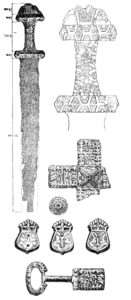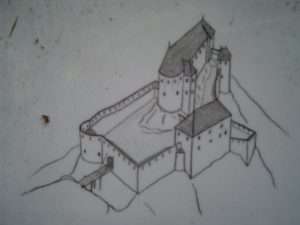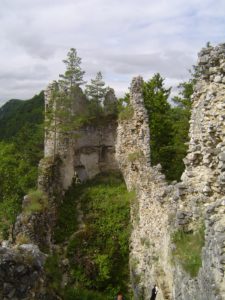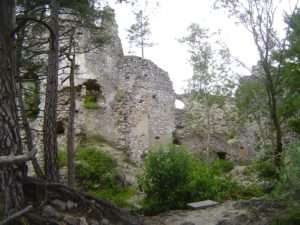Blatnica
The village of Blatnica is situated 18 km south of the village of Turócszentmárton, in the district of Szebeszló (Sebeslavce) in Slovakia, and its castle was built in the Kingdom of Hungary after the Mongol invasion of 1241.

The Blatnica stream flows at 500 meters above sea level, and the Blatnica Castle rises above 685 meters. A gentle but steep path leads up to the gate opening in the stone wall of the lower part of the castle. It was defended by a semicircular tower in the western corner.

On the northeast side, we can see a defensive wall, probably built in the 16th century. On the western ridge, 6-8 meters above the mound there is the upper castle. According to the assumptions of the excavations, the northern large round tower, which rises from the highest point of the narrow rocky ridge, and with its narrow, 14-meter-long walls, may date from the early 14th century.

Opposite the gate of the upper castle, the outer wall is protected by a small four-cornered tower. Blatnica Castle is one of the fortifications that were not built according to modern principles of warfare but remained a third-rate military shelter of the aristocrats. In the 1790s, the Révay family moved from their uncomfortable former residence to the Baroque castle built in the village, and since then the walls have rapidly deteriorated.

It was written as “Blathnicha” in 1252. In a document from 1272 it is still mentioned as a “villa” in the Blatnica region, but it was not mentioned in the early 14th century during the wars of the oligarch Csák Máté, who occupied significant parts of Upper Hungary. Around 1300 it belonged to Peter of Berzevice. In 1323 it was mentioned under the name of Blatnicze. The army of the Hungarian King Károly Róbert entered the country in 1321 after the collapse of Csák’s power.

The victorious ruler appointed Magister Doncs, son of Domokos, as the head of the Zólyom forest district. This vast area, which stretched from the Garam River to the Tátra Hills, was later divided into the counties of Zólyom, Turóc, Árva and Liptó.
Master Doncs was one of the great castle builders of the time and his name should be mentioned in connection with the construction of the fortifications of Liptóújvár, Likava, and Blatnica. The first documented mention of Blatnica Castle, which has survived to the present day, dates back to 1341 when the monarch acquired it in exchange for the Valkó castle estate. In the following decades, the royal Comes lords of Turóc also held the office of Blatnica’s castellan. After the accession to the throne of King Sigismund of Luxembourg, the castle passed into private ownership, and in 1389 it was donated to the nobleman Pogány Domokos because the king wanted to enlarge his initially small circle of supporters.

The following year, however, he exchanged the stone castle and pledged it to Prince Oppelni László, together with all the serf villages belonging to it. In 1361 it was mentioned in written sources under the name of “Plathnicha”. In 1415, Sigismund confirmed the pledge of Blatnica Castle to the grandsons of the Palatine Oppelni László, the Dukes of Glogau, as the Palatine had died in the meantime. After the pledge was repaid in 1421, it was held by the chamberlain Berzeviczy Péter [+1433] as a lifelong trustee.

According to contemporary sources, from 1434 Queen Cillei Borbála enjoyed the income from the castle. Soon she mortgaged it for 2,300 gold pieces to the nobleman Pongrácz of Liptó, who at that time held the office of the castle’s keeper in Blatnica. In 1441 Pongrácz sold it for 9,000 gold pieces to the nobleman Necpály László, and later his son-in-law Szentmiklósi Pongrác István bought it.

The darkest period of Blatnica Castle was between 1450 and 1470 when it was ruled by the Polish Peter Komorowsky and his armed men. This robber knight originally came to the Highlands as an ally of the Czech Hussite leader Jan Giskra, but when the Czechs made peace with King Hunyadi Mátyas in 1462, he too was pardoned.

In 1471, however, he joined a conspiracy of Hungarian nobles unhappy with their ruler’s policies to bring in the Polish prince Kazmér as a pretender to the throne. Their plan failed miserably and in the spring of 1474 Matthias Corvinus took his revenge.

On his orders, a royal army besieged Komorowski’s castles, including Blatnica, Likavár, Liptóújvár and Liptóvár. One by one, they besieged and captured the forces of the robber knight, who, finally trapped in Árva, asked for and received mercy from Matthias. It is typical of the ruler’s generosity that the former feared lord, who was paid eight thousand gold pieces, was able to live in peace until the day of his death. All in all, in the 15th century, it had several owners, such as the Neczpáli, Komoro, Ernst, Onofri, Csécsényi, and Szapolyai families.

The estate, which had come under royal administration, was donated to the Révay family, who were the unconditional supporters of the Hungarian King Ferdinand Habsburg, the Austrian Archduke who conquered the Highlands in the middle of the 16th century. It is known that at that time there were only 5 serf villages with landlord services. Later, we could find 17 villages attached to it.

Far from the bloody battlefields of the Turkish wars, the fortress remained the center of the aristocratic domain, with the castle buildings crowning the steep hilltop housing members of the family and their servants. In time, the walls were extended, but no modern defense works or bastions were built to withstand the cannonade, so the small garrison naturally opened its gates without a fight to the rebel army of Bocskai István in 1606, and later to the troops of the Transylvanian prince Bethlen Gábor.

It is recorded that the castle buildings were burnt down in 1678, perhaps as a result of an attack by the Kuruc rebels. It was soon rebuilt by the Révay family, and in 1687 Permay András, a tax collector from Zsolna, made an inventory of the castle’s possessions, including documents, books, and clothes, stored in boxes.

At the end of 1703, the Kuruc soldiers of Prince Rákóczi Ferenc II, who had organized an uprising against the autocratic rule of the Habsburg emperor and king, conquered the fortress without a stroke of the sword. They were forced to retreat from its walls in the autumn of 1708, after being defeated in the Battle of Trencsén. It was reclaimed by its rightful owners, the Révay family. Their unwavering loyalty to the Habsburgs during the Kuruc War of Independence saved Blatnica Castle from the order to blow up the fortifications in the Kingdom of Hungary that had become redundant.

They continued to occupy their buildings after 1711, although some members of the family moved to their more comfortable Baroque castles built in the villages along the valley. According to contemporary sources, the crumbling walls of the medieval castle were repaired by the hereditary archbishop Révay József in 1744, but the last inhabitants of Blatnica Castle moved out in 1790.

Over the centuries, the castle, which had become a ruinous fortress, was badly damaged by the weather, and its stone walls and buildings partly collapsed. According to Fényes Elek (1851), from the Tiszta Hill near the ruins of Blatnica, the visitor could see as far as the castle of Pozsony (Pressburg, Bratislava), if the weather was clear. Note: the hill’s name is “tlstá” in Slovak. I was told that it means “fat” and that the 2 hills are “tlstá and ostrá” (Fat and Sharp)”. The castle’s restoration and renovation began in 2011 and is still ongoing.

Dear Readers, I can only make this content available through small donations or by selling my books or T-shirts:
Please, feel free to support me with a coffee here:
You can check out my books "33 Castles, Battles, Legends" and "The Ring of Kékkő Castle" on Amazon or Draft2Digital, they are available in hardcover, paperback, or ebook: https://www.amazon.com/dp/198020490X or at https://books2read.com/b/boYd81
 My work can also be followed and supported on Patreon: Become a Patron!http://Become a Patron!
My work can also be followed and supported on Patreon: Become a Patron!http://Become a Patron!


https://hungarianottomanwars.myspreadshop.com/all
































